Effect of Marble Waste Powder as a Binder Replacement on the Mechanical Resistance of Cement Mortars
Abstract
:1. Introduction
2. Experimental Procedures
2.1. Materials
2.2. Mortar Mixes
2.3. Methods
3. Results and Discussion
3.1. Physical and Chemical Characteristics of the Selected Materials
3.2. Mechanical Properties of Mortars
4. Conclusions
Author Contributions
Funding
Institutional Review Board Statement
Informed Consent Statement
Data Availability Statement
Acknowledgments
Conflicts of Interest
References
- Herz, N.; Waelkens, M. Classical Marble: Geochemistry, Technology, Trade; Brill Archive: Leiden, The Netherlands, 1988; Volume 153. [Google Scholar]
- Greenhalgh, M. Marble Past, Monumental Present: Building with Antiquities in the Mediaeval Mediterranean; Brill: Leiden, The Netherlands, 2009; Volume 80. [Google Scholar]
- Attanasio, D.; Platania, R.; Rocchi, P. The marble of the David of Michelangelo: A multi-method analysis of provenance. J. Archaeol. Sci. 2005, 32, 1369–1377. [Google Scholar] [CrossRef]
- Gazi, A.; Skevis, G.; Founti, M.A. Energy efficiency and environmental assessment of a typical marble quarry and processing plant. J. Clean. Prod. 2012, 32, 10–21. [Google Scholar] [CrossRef]
- Worrell, E.; Price, L.; Martin, N.; Hendriks, C.; Meida, L.O. Carbon dioxide emissions from the global cement industry. Annu. Rev. Energy Environ. 2001, 26, 303–329. [Google Scholar] [CrossRef]
- Founti, M.A.; Giannopoulos, D.; Laskaridis, K. Environmental management aspects for energy saving in natural stone quarries. In Proceedings of the Global Stone Congress, Alicante, Spain, 2–5 March 2010. [Google Scholar]
- Montani, C. XXVII World Marble and Stones Report 2016; Aldus: Carrara, Italy, 2016. [Google Scholar]
- Giusti, L. A review of waste management practices and their impact on human health. Waste Manag. 2009, 29, 2227–2239. [Google Scholar] [CrossRef]
- Aliabdo, A.A.; Elmoaty, A.E.M.A.; Auda, E.M. Re-use of waste marble dust in the production of cement and concrete. Constr. Build. Mater. 2014, 50, 28–41. [Google Scholar] [CrossRef]
- Cantisani, E.; Fratini, F.; Malesani, P.; Molli, G. Mineralogical and petrophysical characterisation of white Apuan marble. Period. Mineral. 2005, 74, 117–138. [Google Scholar]
- Franzini, M.; Lezzerini, M. The Triassic marble from the Punta Bianca promontory (La Spezia, Italy). Did Romen quarrying of ‘lunensis marble’ begin here? Period. Mineral. 2002, 71, 137–144. [Google Scholar]
- Lezzerini, M.; di Battistini, G.; Zucchi, D.; Miriello, D. Provenance and compositional analysis of marbles from the medieval Abbey of San Caprasio, Aulla (Tuscany, Italy). Appl. Phys. A Mater. Sci. Process. 2012, 108, 475–485. [Google Scholar] [CrossRef]
- Conti, P.; Carmignani, L.; Giglia, G.; Meccheri, M.; Fantozzi, P.L. Evolution of geological interpretations in the Alpi Apuane Metamorphic Complex, and their relevance for the geology of the Northern Apennines. In The Regione Toscana Project of Geological Mapping; Morini, D., Bruni, P., Eds.; Regione Toscana-Servizio Geologica Regionale: Firenze, Italy, 2004; pp. 241–262. [Google Scholar]
- Demirel, B. The effect of the using waste marble dust as fine sand on the mechanical properties of the concrete. Int. J. Phys. Sci. 2010, 5, 1372–1380. [Google Scholar]
- Bilgin, N.; Yeprem, H.A.; Arslan, S.; Bilgin, A.; Günay, E.; Marşoglu, M. Use of waste marble powder in brick industry. Constr. Build. Mater. 2012, 29, 449–457. [Google Scholar] [CrossRef]
- Talah, A.; Kharchi, F.; Chaid, R. Influence of marble powder on high performance concrete behavior. Procedia Eng. 2015, 114, 685–690. [Google Scholar] [CrossRef] [Green Version]
- Sadek, D.M.; El-Attar, M.M.; Ali, H.A. Reusing of marble and granite powders in self-compacting concrete for sustainable development. J. Clean. Prod. 2016, 121, 19–32. [Google Scholar] [CrossRef]
- Li, L.G.; Huang, Z.H.; Tan, Y.P.; Kwan, A.K.H.; Liu, F. Use of marble dust as paste replacement for recycling waste and improving durability and dimensional stability of mortar. Constr. Build. Mater. 2018, 166, 423–432. [Google Scholar] [CrossRef]
- Ashish, D.K. Concrete made with waste marble powder and supplementary cementitious material for sustainable development. J. Clean. Prod. 2019, 211, 716–729. [Google Scholar] [CrossRef]
- Singh, M.; Choudhary, K.; Srivastava, A.; Sangwan, K.S.; Bhunia, D. A study on environmental and economic impacts of using waste marble powder in concrete. J. Build. Eng. 2017, 13, 87–95. [Google Scholar] [CrossRef]
- Seghir, N.T.; Mellas, M.; Sadowski, Ł.; Krolicka, A.; Żak, A.; Ostrowski, K. The utilization of waste marble dust as a cement replacement in air-cured mortar. Sustainability 2019, 11, 2215. [Google Scholar] [CrossRef] [Green Version]
- Garbarino, E.; Orveillon, G.; Saveyn, H.G.M. Management of waste from extractive industries: The new European reference document on the Best Available Techniques. Resour. Policy 2020, 69, 101782. [Google Scholar] [CrossRef]
- Ma, B.; Wang, J.; Tan, H.; Li, X.; Cai, L.; Zhou, Y.; Chu, Z. Utilization of waste marble powder in cement-based materials by incorporating nano silica. Constr. Build. Mater. 2019, 211, 139–149. [Google Scholar] [CrossRef]
- Sufian, M.; Ullah, S.; Ostrowski, K.A.; Ahmad, A.; Zia, A.; Śliwa-Wieczorek, K.; Siddiq, M.; Awan, A.A. An experimental and empirical study on the use of waste marble powder in construction material. Materials 2021, 14, 3829. [Google Scholar] [CrossRef]
- Nayak, S.K.; Satapathy, A.; Mantry, S. Use of waste marble and granite dust in structural applications: A review. J. Build. Eng. 2022, 46, 103742. [Google Scholar] [CrossRef]
- Benjeddou, O.; Alyousef, R.; Mohammadhosseini, H.; Soussi, C.; Khadimallah, M.A.; Alabduljabbar, H.; Tahir, M.M. Utilisation of waste marble powder as low-cost cementing materials in the production of mortar. J. Build. Eng. 2020, 32, 101642. [Google Scholar] [CrossRef]
- Passarini, F.; Vassura, I.; Monti, F.; Morselli, L.; Villani, B. Indicators of waste management efficiency related to different territorial conditions. Waste Manag. 2011, 31, 785–792. [Google Scholar] [CrossRef] [PubMed]
- Drysdale, R.; Pierotti, L.; Piccini, L.; Baldacci, F. Suspended sediments in karst spring waters near Massa (Tuscany), Italy. Environ. Geol. 2001, 40, 1037–1050. [Google Scholar]
- Rizzo, G.; D’Agostino, F.; Ercoli, L. Problems of soil and groundwater pollution in the disposal of ‘marble’ slurries in NW Sicily. Environ. Geol. 2008, 55, 929–935. [Google Scholar] [CrossRef]
- Demirel, B.; Alyamaç, K.E. Waste marble powder/dust. In Waste and Supplementary Cementitious Materials in Concrete; Elsevier: Amsterdam, The Netherlands, 2018; pp. 181–197. [Google Scholar]
- L:2008:312:TOC; Directive 2008/98/EC of the European Parliament and of the Council on Waste and Repealing Certain Directives. Official Journal of the European Union: Brussels, Belgum, 2008; pp. 3–30.
- Law 205; Legislative Decree No.105 of the 08 July 2010, Urgent Measures on Energy. Official Journal of the European Union: Brussels, Belgum, 2010; pp. 1–78.
- Vardhan, K.; Goyal, S.; Siddique, R.; Singh, M. Mechanical properties and microstructural analysis of cement mortar incorporating marble powder as partial replacement of cement. Constr. Build. Mater. 2015, 96, 615–621. [Google Scholar] [CrossRef]
- Xiao, J.; Ma, Z.; Sui, T.; Akbarnezhad, A.; Duan, Z. Mechanical properties of concrete mixed with recycled powder produced from construction and demolition waste. J. Clean. Prod. 2018, 188, 720–731. [Google Scholar] [CrossRef]
- Drzymała, T.; Zegardło, B.; Tofilo, P. Properties of concrete containing recycled glass aggregates produced of exploded lighting materials. Materials 2020, 13, 226. [Google Scholar] [CrossRef] [Green Version]
- Tomasz, D.; Bartosz, Z.; Wioletta, J.-R.; Daniel, S. The effect of high temperatures on the flexural strength of cement mortar modified by the addition of polypropylene fibres. Saf. Fire Technol. 2018, 51, 26–39. [Google Scholar]
- Oza, R.B.; Kangda, M.Z.; Agrawal, M.R.; Vakharia, P.R.; Solanki, D.M. Marble dust as a binding material in concrete: A review. Mater. Today Proc. 2022. [Google Scholar] [CrossRef]
- Ruiz-Sánchez, A.; Sánchez-Polo, M.; Rozalen, M. Waste marble dust: An interesting residue to produce cement. Constr. Build. Mater. 2019, 224, 99–108. [Google Scholar] [CrossRef]
- Ergün, A. Effects of the usage of diatomite and waste marble powder as partial replacement of cement on the mechanical properties of concrete. Constr. Build. Mater. 2011, 25, 806–812. [Google Scholar] [CrossRef]
- Arel, H.Ş. Recyclability of waste marble in concrete production. J. Clean. Prod. 2016, 131, 179–188. [Google Scholar] [CrossRef]
- Ashish, D.K.; Verma, S.K.; Kumar, R.; Sharma, N. Properties of concrete incorporating sand and cement with waste marble powder. Adv. Concr. Constr. 2016, 4, 145. [Google Scholar] [CrossRef]
- Corinaldesi, V.; Moriconi, G.; Naik, T.R. Characterization of marble powder for its use in mortar and concrete. Constr. Build. Mater. 2010, 24, 113–117. [Google Scholar] [CrossRef]
- Hebhoub, H.; Aoun, H.; Belachia, M.; Houari, H.; Ghorbel, E. Use of waste marble aggregates in concrete. Constr. Build. Mater. 2011, 25, 1167–1171. [Google Scholar] [CrossRef]
- Keleştemur, O.; Arıcı, E.; Yıldız, S.; Gökçer, B. Performance evaluation of cement mortars containing marble dust and glass fiber exposed to high temperature by using Taguchi method. Constr. Build. Mater. 2014, 60, 17–24. [Google Scholar] [CrossRef] [Green Version]
- Khyaliya, R.K.; Kabeer, K.I.S.A.; Vyas, A.K. Evaluation of strength and durability of lean mortar mixes containing marble waste. Constr. Build. Mater. 2017, 147, 598–607. [Google Scholar] [CrossRef]
- Seghir, N.T.; Mellas, M.; Sadowski, Ł.; Żak, A. Effects of marble powder on the properties of the air-cured blended cement paste. J. Clean. Prod. 2018, 183, 858–868. [Google Scholar] [CrossRef]
- Yamanel, K.; Durak, U.; İlkentapar, S.; Atabey, I.; Karahan, O.; TİŞ, C.A. Influence of waste marble powder as a replacement of cement on the properties of mortar. Rev. Constr. 2019, 18, 290–300. [Google Scholar] [CrossRef]
- Nasr, M.S.; Shubbar, A.A.; Abed, Z.A.-A.R.; Ibrahim, M.S. Properties of eco-friendly cement mortar contained recycled materials from different sources. J. Build. Eng. 2020, 31, 101444. [Google Scholar] [CrossRef]
- Al Jaaf, H.J.M.; Al-Jadiri, R.S.; Abdulghani, H.A. A Review on the Influence of Introducing Waste Materials to the Properties of Cement Mortar. J. Constr. Build. Mater. Eng. 2022, 8, 19–24. [Google Scholar]
- Khan, M.N.N.; Jamil, M.; Karim, M.R.; Zain, M.F.M.; Kaish, A. Filler effect of pozzolanic materials on the strength and microstructure development of mortar. KSCE J. Civ. Eng. 2017, 21, 274–284. [Google Scholar] [CrossRef]
- Miriello, D.; Lezzerini, M.; Chiaravalloti, F.; Bloise, A.; Apollaro, C.; Crisci, G.M. Replicating the chemical composition of the binder for restoration of historic mortars as an optimization problem. Comput. Concr. 2013, 12, 553–563. [Google Scholar] [CrossRef]
- Torres, M.L.; García-Ruiz, P.A. Lightweight pozzolanic materials used in mortars: Evaluation of their influence on density, mechanical strength and water absorption. Cem. Concr. Compos. 2009, 31, 114–119. [Google Scholar] [CrossRef]
- EN 196-1; Methods of Testing Cement—Part 1: Determination of Strength. European Standard: Brussels, Belgium, 2016.
- Franzini, M.; Leoni, M.; Saitta, L. Revisione di una metodologia analitica per fluorescenza-X, basata sulla correzione completa degli effetti di matrice. Rend. Soc. Ital. Miner. Petrog. 1975, 31, 365–378. [Google Scholar]
- Lezzerini, M.; Tamponi, M.; Bertoli, M. Reproducibility, precision and trueness of X-ray fluorescence data for mineralogical and/or petrographic purposes. Atti Soc. Toscana Sci. Nat. Mem. Ser. A 2013, 120, 67–73. [Google Scholar] [CrossRef]
- EN 933-1; Tests for Geometrical Properties of Aggregates—Part 1: Determination of Particle Size Distribution—Sieving Method. European Standard: Brussels, Belgium, 2012.
- EN 933-2; Tests for Geometrical Properties of Aggregates—Part 2: Determination of Particle Size Distribution—Test Sieves, Nominal Size of Apertures. European Standard: Brussels, Belgium, 2020.
- EN 15801; Conservation of Cultural Property—Test Methods—Determination of Water Absorption by Capillarity. European Standard: Brussels, Belgium, 2009.
- EN 13755; Natural Stone Test Methods—Determination of Water Absorption at Atmospheric Pressure. European Standard: Brussels, Belgium, 2008.
- EN 1015-10; Methods of Test for Mortar for Masonry—Part 10: Determination of Dry Bulk Density of Hardened Mortar. European Standard: Brussels, Belgium, 1999.
- Franzini, M.; Lezzerini, M. A mercury-displacement method for stone bulk-density determinations. Eur. J. Mineral. 2003, 15, 225–229. [Google Scholar] [CrossRef]
- EN 1015-11; Methods of Test for Mortar for Masonry—Part 11: Determination of Flexural and Compressive Strength of Hardened Mortar. European Standard: Brussels, Belgium, 2019.
- EN 12504-4; Testing Concrete—Part 4: Determination of Ultrasonic Pulse Velocity. European Standard: Brussels, Belgium, 2004.
- Moropoulou, A.; Bakolas, A.; Bisbikou, K. Investigation of the technology of historic mortars. J. Cult. Herit. 2000, 1, 45–58. [Google Scholar] [CrossRef]
- Franzini, M.; Leoni, L.; Lezzerini, M.; Sartori, F. The mortar of the ‘Leaning Tower’ of Pisa: The product of a Medieval technique for preparing high-strength mortars. Eur. J. Mineral. 2000, 12, 1151–1163. [Google Scholar] [CrossRef]
- Moropoulou, A.; Bakolas, A.; Anagnostopoulou, S. Composite materials in ancient structures. Cem. Concr. Compos. 2005, 27, 295–300. [Google Scholar] [CrossRef]
- Jackson, M.; Deocampo, D.; Marra, F.; Scheetz, B. Mid-Pleistocene pozzolanic volcanic ash in ancient Roman concretes. Geoarchaeol. Int. J. 2010, 25, 36–74. [Google Scholar] [CrossRef]
- Belfiore, C.M.; Fichera, G.V.; Ortolano, G.; Pezzino, A.; Visalli, R.; Zappalà, L. Image processing of the pozzolanic reactions in Roman mortars via X-Ray Map Analyser. Microchem. J. 2016, 125, 242–253. [Google Scholar] [CrossRef]
- Lezzerini, M.; Raneri, S.; Pagnotta, S.; Columbu, S.; Gallello, G. Archaeometric study of mortars from the Pisa’s Cathedral Square (Italy). Meas. J. Int. Meas. Confed. 2018, 126, 322–331. [Google Scholar] [CrossRef] [Green Version]
- Rispoli, C.; De Bonis, A.; Guarino, V.; Graziano, S.F.; Di Benedetto, C.; Esposito, R.; Morra, V.; Cappelletti, P. The ancient pozzolanic mortars of the Thermal complex of Baia (Campi Flegrei, Italy). J. Cult. Herit. 2019, 40, 143–154. [Google Scholar] [CrossRef]
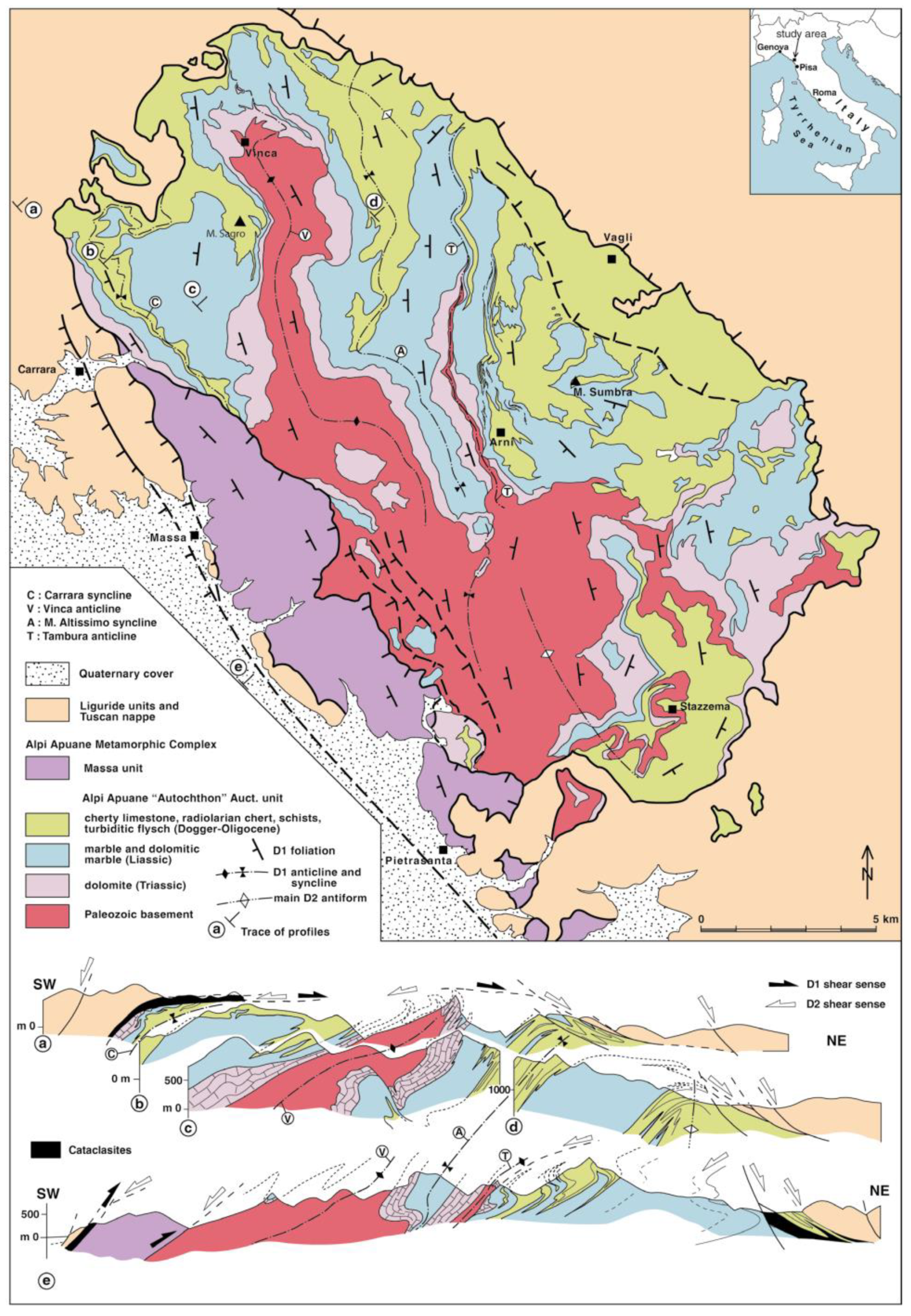
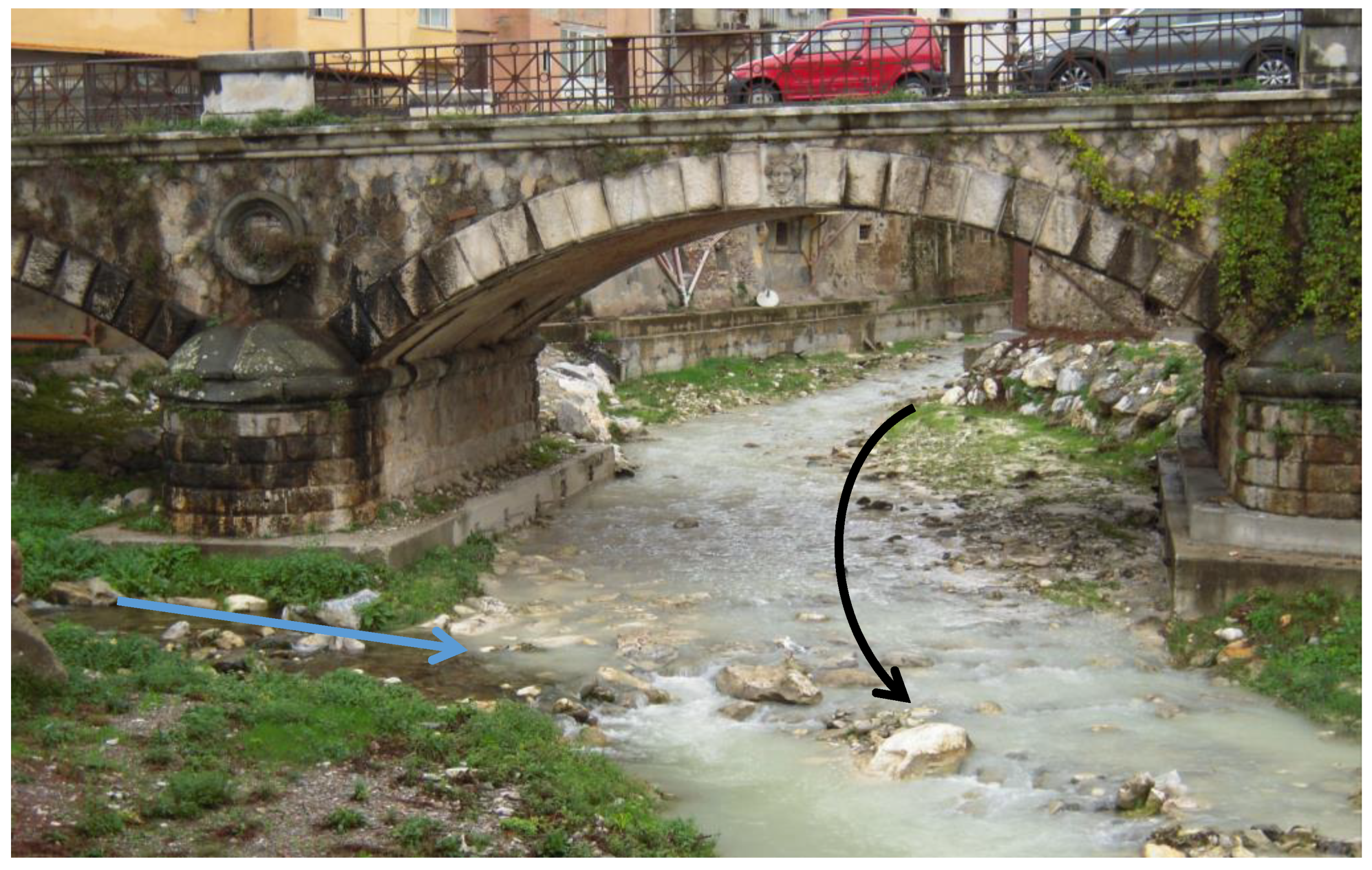
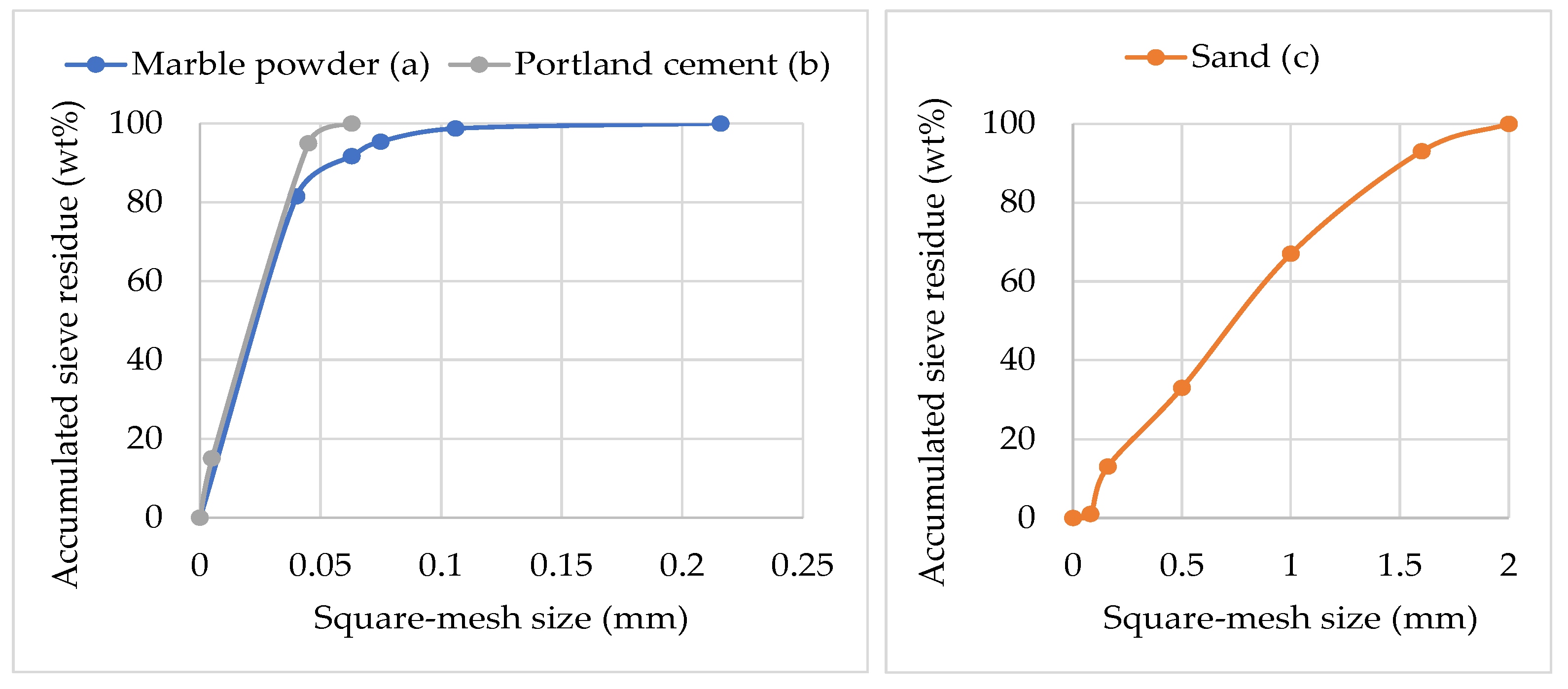
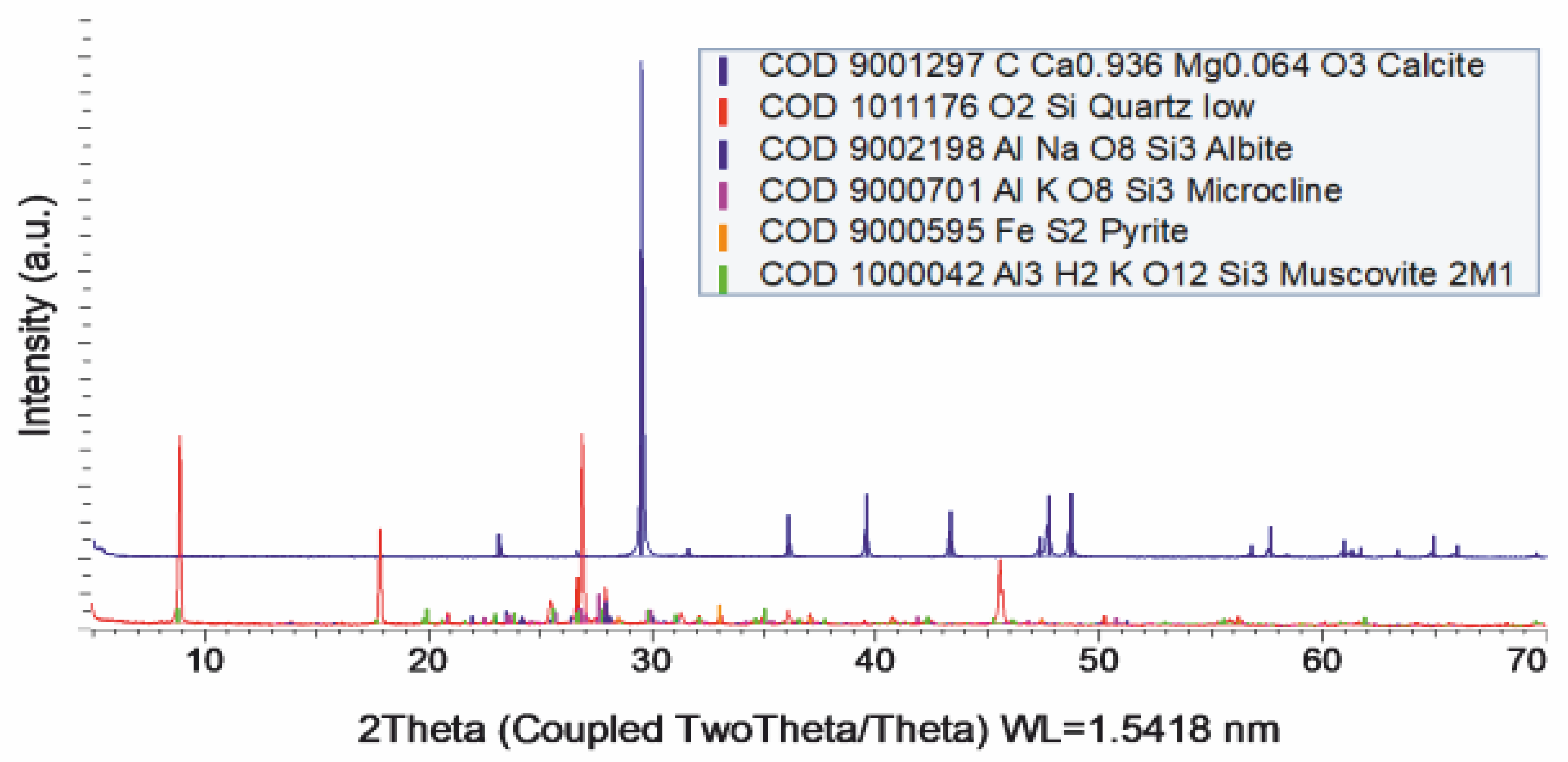
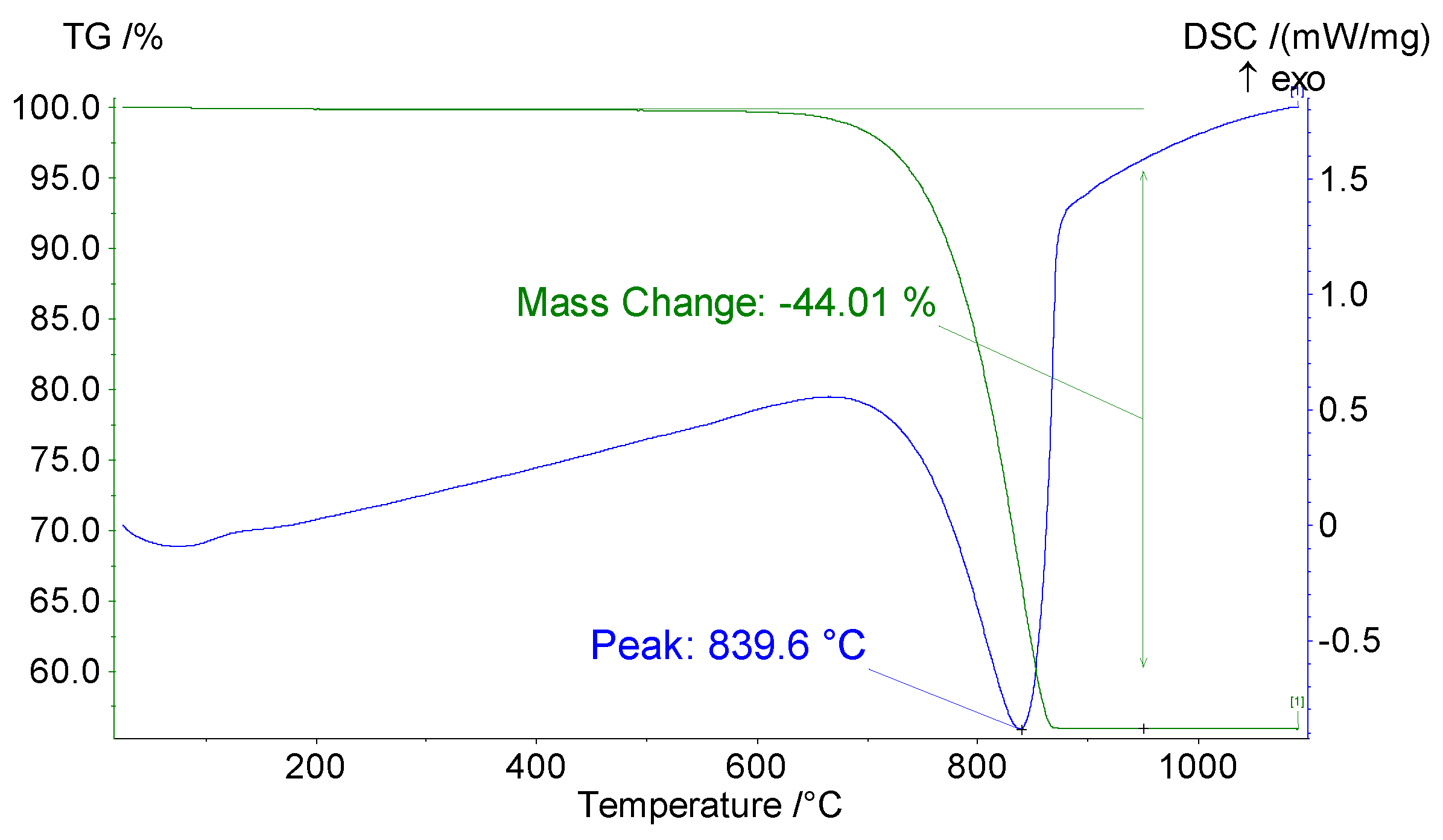
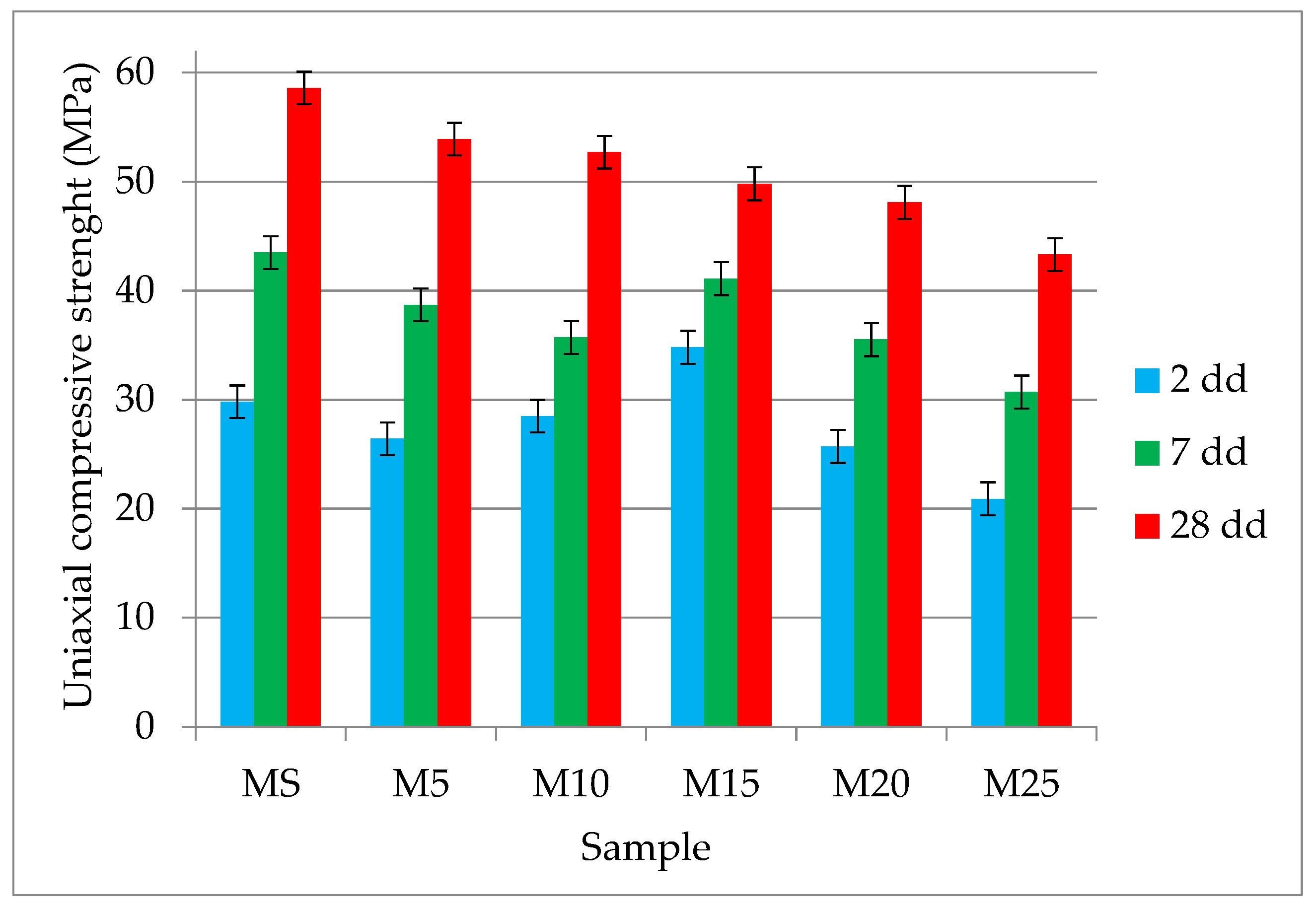
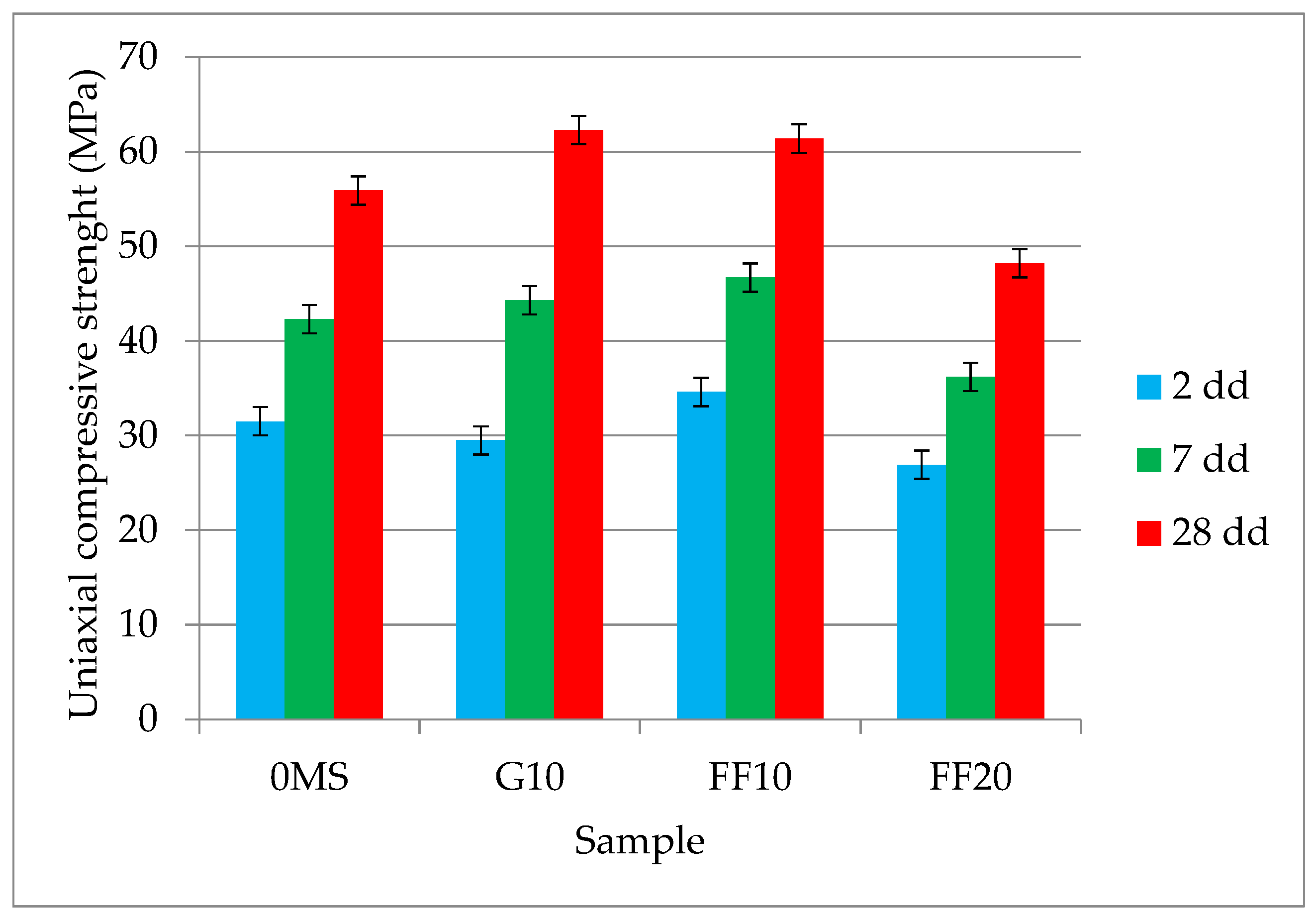
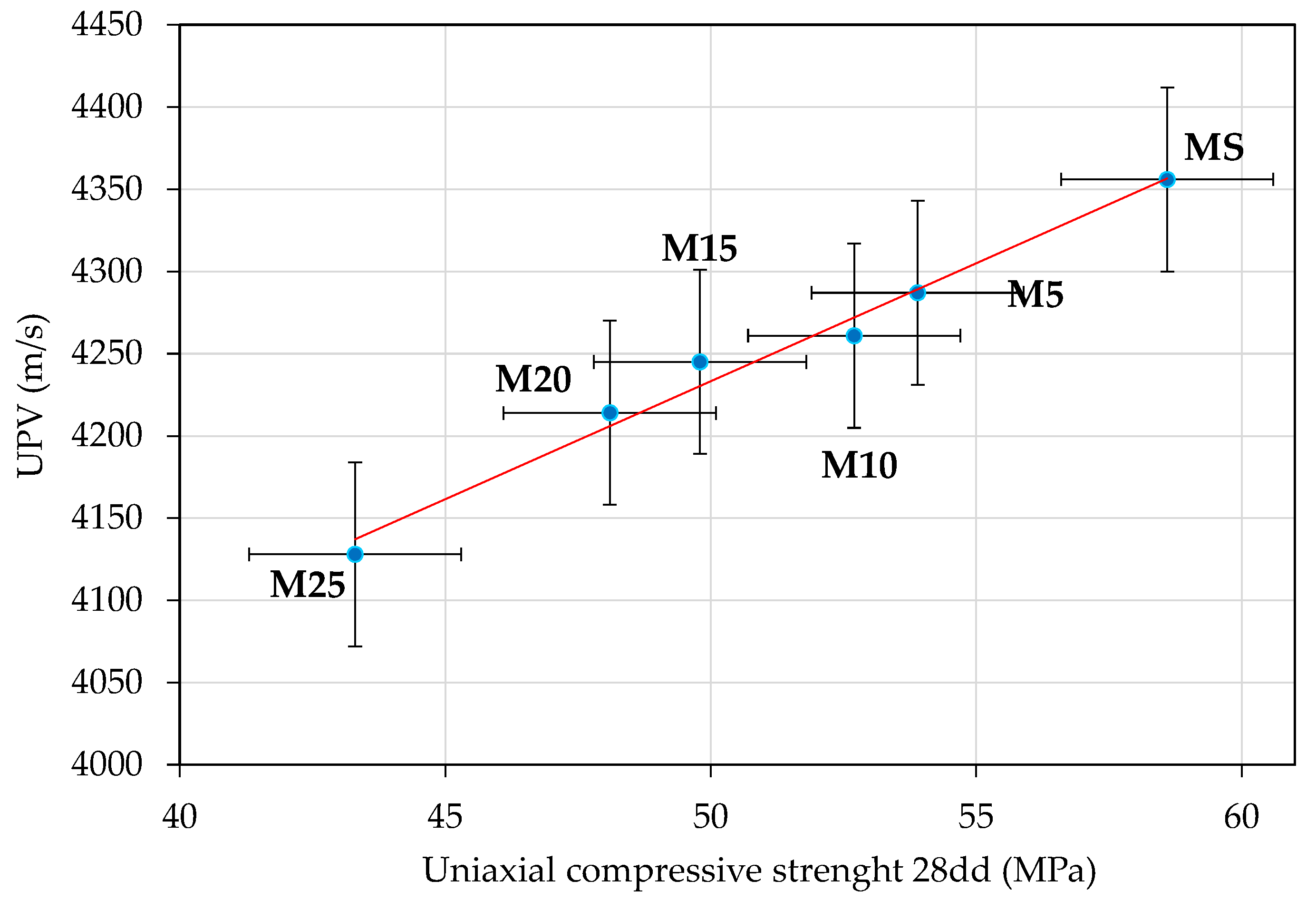
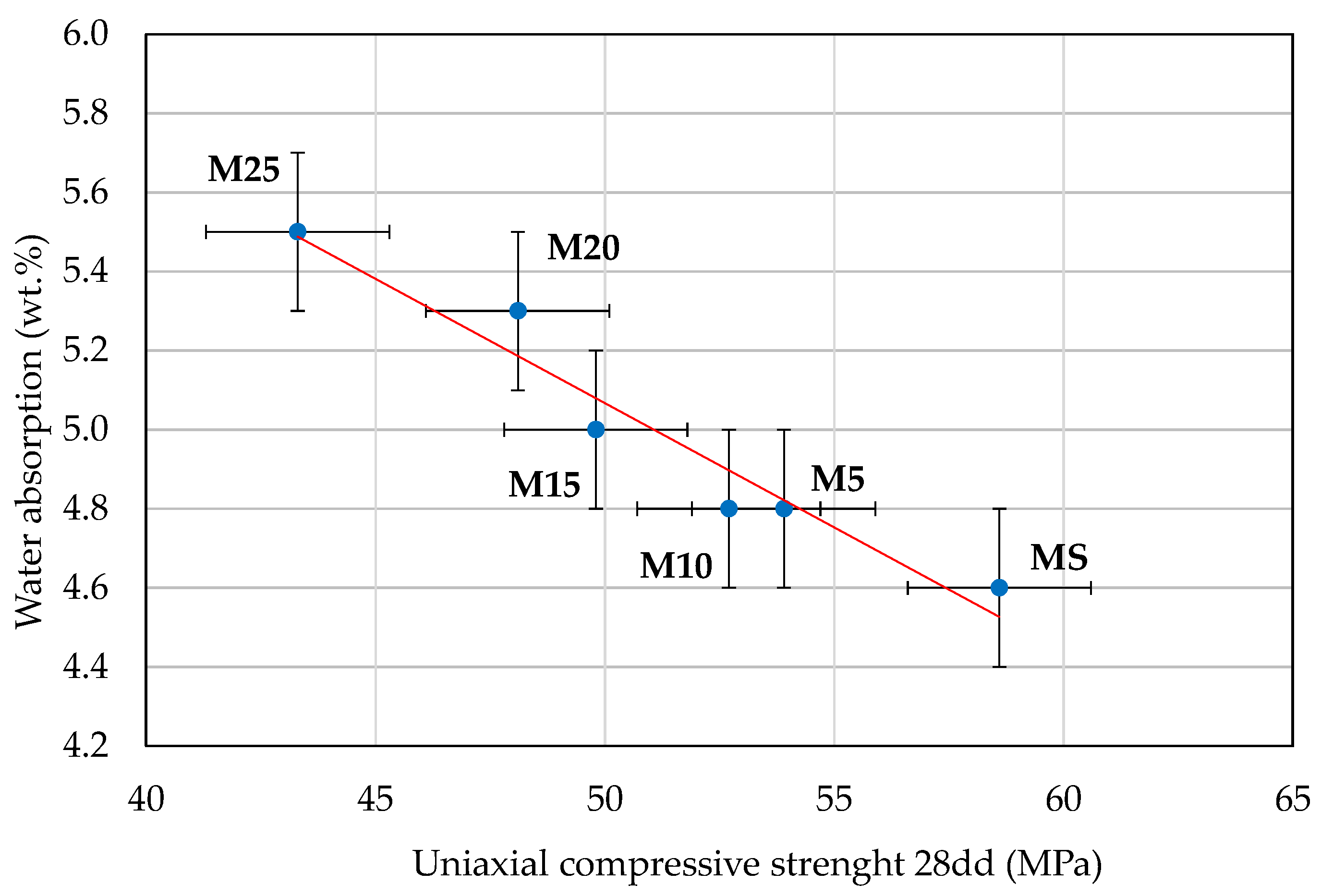
| Material | Description |
|---|---|
| Portland cement (C) | Colacem, CEM I 52.5 R |
| Sand (S) | Normalized sand |
| Marble (M) | Marble powder |
| Water (W) | Demineralized water |
| Superplasticizer additive (A) | Basf, MasterGlenium SKY 698 |
| Sample | Binder/Aggregate | Water/Binder Ratio (wt.%) | Superplasticizer (wt.%) |
|---|---|---|---|
| MS | 1:3 | 0.5 | 0.1 |
| 0MS | 1:3 | 0.5 | - |
| Mortar Mixture | Cement Substitution (wt.%) | Superplasticizer Amount (wt.%) |
|---|---|---|
| M5 | 5 | 0.2 |
| M10 | 10 | 0.3 |
| M15 | 15 | 0.4 |
| M20 | 20 | 0.5 |
| M25 | 25 | 0.6 |
| Sample | L.O.I. | Na2O | MgO | Al2O3 | SiO2 | P2O5 | K2O | CaO | TiO2 | MnO | Fe2O3 | SG |
|---|---|---|---|---|---|---|---|---|---|---|---|---|
| C | 3.31 | 0.21 | 3.07 | 1.49 | 16.6 | 0.5 | 0.88 | 69.26 | 0.19 | 0.15 | 4.34 | 3.19 |
| S | <0.01 | 0.14 | 0.22 | 0.95 | 97.12 | 0.06 | 0.3 | 0.32 | 0.07 | 0.02 | 0.8 | 2.65 |
| M | 42.94 | <0.01 | 1.75 | <0.01 | 1.74 | 0.13 | <0.01 | 52.34 | 0.02 | 0.03 | 1.05 | 2.71 |
| Mean SD = 2.0 MPa | Cement Replacement (r, wt.%) | Compressive Strength (σ, MPa) | ||
|---|---|---|---|---|
| Sample | 2 dd | 7 dd | 28 dd | |
| 0MS | 0 | 31.5 | 42.3 | 55.9 |
| MS | 0 | 29.8 | 43.5 | 58.6 |
| M5 | 5 | 26.4 | 38.7 | 53.9 |
| M10 | 10 | 28.5 | 35.7 | 52.7 |
| M15 | 15 | 34.8 | 41.1 | 49.8 |
| M20 | 20 | 25.7 | 35.5 | 48.1 |
| M25 | 25 | 20.9 | 30.7 | 43.3 |
| G10 | 10 | 29.5 | 44.3 | 62.3 |
| FF10 | 10 | 34.6 | 46.7 | 61.4 |
| FF20 | 20 | 26.9 | 36.2 | 48.2 |
| Sample | UPV (m/s) |
|---|---|
| Mean SD = 56 m/s | |
| MS | 4356 |
| M5 | 4287 |
| M10 | 4261 |
| M15 | 4245 |
| M20 | 4214 |
| M25 | 4128 |
| Sample | Apparent Density (g/cm3) | Capillarity Absorption Coefficient (g/m2 s0.5) | Water Absorption (wt.%) | Water Absorption (vol.%) |
|---|---|---|---|---|
| Mean SD = 0.02 g/cm3 | Mean SD = 1.2 g/m2 s0.5 | Mean SD = 0.2% | Mean SD = 0.5% | |
| MS | 2.18 | 14.2 | 4.6 | 10.0 |
| M5 | 2.19 | 13.2 | 4.8 | 10.4 |
| M10 | 2.18 | 13.5 | 4.8 | 10.4 |
| M15 | 2.16 | 15.2 | 5.0 | 10.9 |
| M20 | 2.15 | 15.0 | 5.3 | 11.4 |
| M25 | 2.13 | 17.7 | 5.5 | 11.8 |
Publisher’s Note: MDPI stays neutral with regard to jurisdictional claims in published maps and institutional affiliations. |
© 2022 by the authors. Licensee MDPI, Basel, Switzerland. This article is an open access article distributed under the terms and conditions of the Creative Commons Attribution (CC BY) license (https://creativecommons.org/licenses/by/4.0/).
Share and Cite
Lezzerini, M.; Luti, L.; Aquino, A.; Gallello, G.; Pagnotta, S. Effect of Marble Waste Powder as a Binder Replacement on the Mechanical Resistance of Cement Mortars. Appl. Sci. 2022, 12, 4481. https://doi.org/10.3390/app12094481
Lezzerini M, Luti L, Aquino A, Gallello G, Pagnotta S. Effect of Marble Waste Powder as a Binder Replacement on the Mechanical Resistance of Cement Mortars. Applied Sciences. 2022; 12(9):4481. https://doi.org/10.3390/app12094481
Chicago/Turabian StyleLezzerini, Marco, Letizia Luti, Andrea Aquino, Gianni Gallello, and Stefano Pagnotta. 2022. "Effect of Marble Waste Powder as a Binder Replacement on the Mechanical Resistance of Cement Mortars" Applied Sciences 12, no. 9: 4481. https://doi.org/10.3390/app12094481
APA StyleLezzerini, M., Luti, L., Aquino, A., Gallello, G., & Pagnotta, S. (2022). Effect of Marble Waste Powder as a Binder Replacement on the Mechanical Resistance of Cement Mortars. Applied Sciences, 12(9), 4481. https://doi.org/10.3390/app12094481









